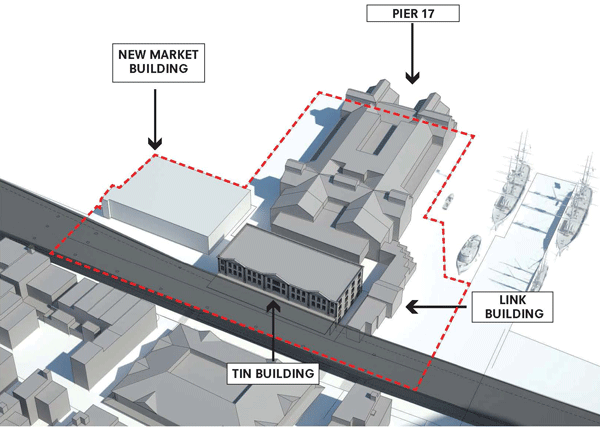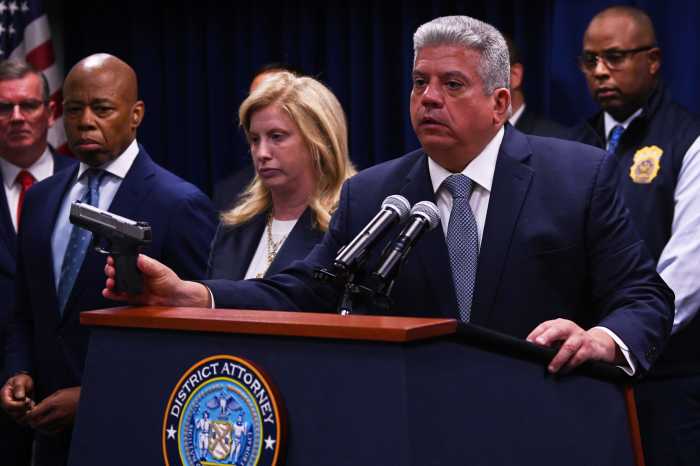
Schematic of the project areas, including the New Market Building, pictured, and the Tin Building.
BY JOSH ROGERS | It’ll be another few months before the public gets to see how much the Howard Hughes Corp. has adjusted its proposed 600-foot tower at the South Street Seaport, but in the meanwhile, the tower has a lot more support than many observers thought.
Since the firm unveiled its proposal last fall, the tower to be built just outside the South Street Seaport Historic District has garnered near universal opposition at public meetings, but on Tuesday, the Seaport Working Group, which includes leading opponents of the project, released a survey showing 26 percent of the comments it received opposed Guideline 6, which calls for alternatives to the tower, and 3 percent offered neutral opinions.
Although 71 percent support for the guideline is high, it was dwarfed by support for the other principles, most of which received at least 95 percent.
“That [26] percent number bothered me last night,” said John Fratta, chairperson of Community Board 1’s Seaport Committee and a member of the working group. “Because it just seemed too high for me.”
The group received 1,946 “eligible comments” on the guidelines either from its online survey or written comments at the public unveiling of the principles June 2, although far fewer commented on any specific principle.
The nine guidelines are carefully-worded and general in nature, allowing opponents and supporters of the Hughes proposal to disagree on whether the firm has already met many of them.
“I think if you look at all the guidelines, I would say the project that we’re envisioning is consistent with those guidelines,” Chris Curry, senior executive vice president of development for Hughes, told Downtown Express last month.
The guidelines also include calls for more open space, historic preservation, and storm resiliency.
Curry, who got a private preview of the findings Monday night along with the rest of the Seaport Working Group, also attended Community Board 1’s Seaport Committee Tuesday, when the survey results were released.
He declined to comment on the results. He confirmed at the meeting that Hughes expects to have its application for Landmarks approval early in September and a new version of the mixed-use tower proposal later in the fall.
That timetable runs counter to the desires of Community Board 1 and many Seaport Working Group members who want to see the entire proposal together.
“It’s still my hope we see everything as a master plan, and we don’t see things in segments and bits and pieces,” said Michael Kramer, a member of Board 1 and the working group.
The tower site, on the New Market Building, would likely include residential apartments and possibly a hotel. It would not need landmarks approval, although officials with the city’s Economic Development Corp., which oversees the city-owned property at the Seaport, have indicated they want to see neighborhood consensus on a proposal before it offered support.
The landmark application will be reviewed by C.B. 1, which will offer an advisory opinion before it goes for approval to the Landmarks Preservation Commission.
The commission is likely to be most concerned about the plan to move the Tin Building and add a rooftop addition. The building, which is decaying, must be raised to meet new storm guidelines, requiring it to be moved because of its proximity to the elevated F.D.R. Drive.
Later in the fall, Hughes plans to submit its application for a Uniform Land Use Procedure, better known as ULURP, in order to build on the tower site. The City Council has the power to stop a ULURP.
By all accounts, Councilmember Margaret Chin and Borough President Gale Brewer, who has an advisory say under ULURP, have been two of the most active members of the working group, which also includes leaders of C.B. 1, neighborhood small business owners and residents, business groups like the Downtown Alliance, as well as the Hughes firm.
Like Brewer, Community Board 1 will have a chance to review the proposal before it goes to the Council.

































